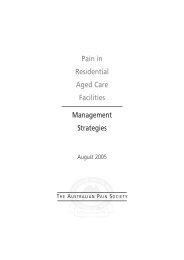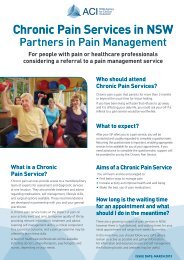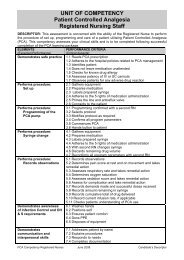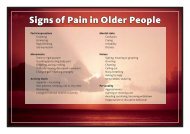The treatment of persistent pain - Australian Pain Society
The treatment of persistent pain - Australian Pain Society
The treatment of persistent pain - Australian Pain Society
You also want an ePaper? Increase the reach of your titles
YUMPU automatically turns print PDFs into web optimized ePapers that Google loves.
� potential death <strong>of</strong> inhibitory neurons due to excessive release<br />
<strong>of</strong> nitrous oxide, with associated interference with inhibitory<br />
neuro-transmitters such as GABA;<br />
� genetic changes associated with long term increase response<br />
<strong>of</strong> neurons; neuroanatomical reorganisation at a brain level,<br />
resulting in increased central representation <strong>of</strong>"<strong>pain</strong>ful areas".<br />
Clinically detectable abnormalities associated with persisting <strong>pain</strong> can<br />
sometimes be difficult to document. On the other hand, patients with<br />
syndromes such as complex regional <strong>pain</strong> syndrome (CRPS) can<br />
manifest striking changes including secondary hyperalgesia, allodynia,<br />
hyperpathia, vasomotor changes, abnormalities in motor function<br />
and trophic changes. It is possible that such clinical abnormalities<br />
may be directly linked to the pathophysiology, which has been<br />
identified in animal models, however, such a linkage has yet to be<br />
made. An exciting opportunity to link abnormalities identified at a<br />
basic level with clinical abnormalities may lie in the use <strong>of</strong> magnetic<br />
resonance spectroscopy (MRS). Philip Siddall and Annie Woodhouse,<br />
in collaboration with Pr<strong>of</strong>essor Carolyn Mountford, have developed<br />
capabilities to detect regional abnormalities in brain function which<br />
seem to show specific patterns for different <strong>pain</strong> states.<br />
Perhaps the strongest evidence currently available is from the clinical<br />
psychology literature where a substantial number <strong>of</strong> abnormalities<br />
have been documented in patients with persisting <strong>pain</strong> including;<br />
high levels <strong>of</strong> anxiety, depression, feelings <strong>of</strong> hopelessness and<br />
helplessness, fear avoidance behaviour, etc. Currently the only factors<br />
that have been identified as being important in the progression from<br />
an acute to a <strong>persistent</strong> phase are in the psychological domain, and<br />
the only available studies relate to patients with low back <strong>pain</strong>. It<br />
would thus seem important to study patients following surgery and<br />
trauma to examine whether psychological factors may also be<br />
important in these areas.<br />
Despite the shortcomings in some <strong>of</strong> the currently available evidence,<br />
there is increasing evidence from the basic and clinical sciences that<br />
persisting <strong>pain</strong> does become a disease entity regardless <strong>of</strong> the<br />
underlying causes <strong>of</strong> the <strong>pain</strong>. Clearly, the primary objective is to<br />
treat any underlying causes. However, there is also a concern now<br />
that such <strong>treatment</strong> <strong>of</strong> underlying causes should be carried out<br />
expeditiously. Otherwise the processes associated with persisting <strong>pain</strong><br />
may move into a <strong>persistent</strong> phase, such that <strong>treatment</strong> <strong>of</strong> the<br />
underlying condition may no longer result in a reversal <strong>of</strong> the <strong>pain</strong><br />
process.<br />
6<br />
This month, the physio spot is introducing<br />
(not that they need introduction!)<br />
Tina Souvlis and Bill Vincenzino<br />
Tina and Bill are doing research at the Department <strong>of</strong> Physiotherapy,<br />
University <strong>of</strong> Queensland, in the area <strong>of</strong> central analgesic and motor<br />
effects associated with manual therapy. Obviously, this is an important<br />
area for anyone doing manual therapy – the more we understand<br />
about why and how these techniques work, the more we promote<br />
targeted and effective intervention.<br />
Comments invited: l.moseley@mailbox.uq.edu.au<br />
Manual therapy and <strong>pain</strong> relief<br />
What reasons spring to mind about the effectiveness <strong>of</strong> manual<br />
therapy? To most people the thought <strong>of</strong> "putting something back<br />
into place" or "getting things moving" ie the biomechanical effects<br />
are paramount. However, musculoskeletal <strong>pain</strong> is one <strong>of</strong> the main<br />
reasons for attendance at physiotherapy clinics. Physiotherapists<br />
along with other medical and health practitioners have long used<br />
manual therapy techniques in the relief <strong>of</strong> <strong>pain</strong>. <strong>The</strong>se techniques<br />
include both manipulation such as a high velocity thrust techniques,<br />
passive oscillatory mobilisation and more recently mobilisation<br />
techniques incorporating active movement.<br />
Manual therapy has long been known anecdotally to be effective<br />
in the management <strong>of</strong> <strong>pain</strong> and the <strong>treatment</strong> <strong>of</strong> musculoskeletal<br />
conditions. In addition, meta-analyses carried out looking at spinal<br />
manual therapy in the management <strong>of</strong> both cervical and lumbar spine<br />
<strong>pain</strong> conditions have demonstrated positive short-term effects.<br />
Although, there is a growing body <strong>of</strong> literature into the biomechanical<br />
effects <strong>of</strong> manual therapy until relatively recently there has been little<br />
research carried out into other potential neurophysiological mechanisms<br />
by which these types <strong>of</strong> <strong>treatment</strong>s may exert some <strong>of</strong> their effects.<br />
<strong>The</strong> potential for spinal manual therapy to activate endogenous <strong>pain</strong><br />
reliving mechanisms was hypothesized by Wright (1995). Since then,<br />
a number <strong>of</strong> studies have demonstrated that spinal and peripheral<br />
manual therapy can produce analgesia which is significantly greater<br />
than that produced by placebo or control techniques in a range <strong>of</strong><br />
conditions. <strong>The</strong> hypoalgesia produced by these <strong>treatment</strong>s have<br />
consistently been shown to be specific to mechanical <strong>pain</strong> thresholds.<br />
Manual therapy <strong>treatment</strong>s do not change thresholds to thermal<br />
<strong>pain</strong>. This change in mechanical threshold is immediate in onset, it is<br />
not reversible by naloxone and does not demonstrate tolerance to







